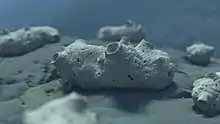Otavia
Otavia antiqua is an early sponge-like fossil found in Namibia in the Etosha National Park. It is claimed to be the oldest animal fossil, being found in rock aged between 760 and 550 million years ago. The genus was named after the Otavi Group in which the fossils were found. The oldest fossils are from the Tonian period, before the Cryogenian glaciations, but the latest found were from the Nama Group rocks, which are from the Ediacaran period.[1]
| Otavia antiqua | |
|---|---|
 | |
| Fossil | |
 | |
| 3D Reconstruction of Otavia antiqua | |
| Scientific classification | |
| Kingdom: | |
| Phylum: | Porifera? |
| Genus: | †Otavia (Brain et al., 2012) |
| Species: | †Otavia antiqua |
| Binomial name | |
| †Otavia antiqua (Brain et al., 2012) | |
The shape of the fossils is irregular but rounded. The size varies from a third of a millimetre to 5 mm (0.20 in). They are hollow inside, and have many small, osculum-like holes connecting the interior to the outside. The material of the outer wall is predominantly calcium phosphate.[1]
The affinities of these fossils, along with other paleontological evidence for precambrian sponges, are disputed.[2]
References
- C. K. 'Bob' Brain; Anthony R. Prave; Karl-Heinz Hoffmann; Anthony E. Fallick; Andre Botha; Donald A. Herd; Craig Sturrock; Iain Young; Daniel J. Condon; Stuart G. Allison (2012). "The first animals: ca. 760-million-year-old sponge-like fossils from Namibia". South African Journal of Science. 108 (1/2). doi:10.4102/sajs.v108i1/2.658.
- Antcliffe, Jonathan B.; Callow, Richard H. T.; Brasier, Martin D. (November 2014). "Giving the early fossil record of sponges a squeeze". Biological Reviews. 89 (4): 972–1004. doi:10.1111/brv.12090. PMID 24779547.
Further reading
- Robert W. Gess (2012). "The oldest animal fossils". South African Journal of Science. 108 (1/2). doi:10.4102/sajs.v108i1/2.1064. ISSN 1996-7489.
- "Namibia sponge fossils are world's first animals: study". PhysOrg.com. 6 February 2012.